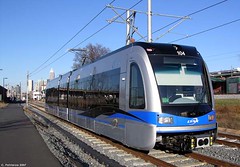Charlotte's web

LYNX Car 104 at Tremont Station, Charlotte. (The system is called the Avanto and is manufactured by Siemens.)
There is lots of ferment in the blog world about the referendum to repeal the 1/2 cent sales tax in Charlotte-Mecklenberg County, North Carolina, a tax dedicated to supporting the developing light rail system there--this system is scheduled to open November 24th. See the tv news story "Light rail line nears completion" and Transit Tax Full coverage of the issue from the Charlotte Observer.
Since I don't dip into the conservative blogworld much or other press, other than the Washington Times, and I can't say I read much of the WT op-ed and editorial writing, just the news sections and the local columnists, I find it interesting but troubling. Even though I think it is hard to retrofit rail into deconcentrated metropolitan regions and get much in the way pro-transit behavior change, although granted in takes decades to make the change.
Portland, Oregon proves that you have to link other compact development and leveraged investment decisions to have significant impact.

From "Charlotte aims for mile-high model: CATS hopes to emulate Denver. What can we expect?" in the Charlotte Observer.
A number of the blogs point to a post based on the book from the Reason Foundation, The Road More Traveled by Balaker and Staley, that I have criticized here before. (The Post ran an op-ed by the authors earlier in the year, "Five Myths About Suburbia and Our Car-Happy Culture.")
But, one of the 10 points, mostly oriented to promoting automobility, is something that I keep meaning to write about:
-----------------------
9. Parking Reform
Eliminating free parking and parking subsidies has reduced driving by up to 24 percent in some cities.
-----------------------
As long as people get free parking, it makes it very difficult for transit to compete, because people don't take into account the sunk cost portion of owning a car (about $5,000 - $7,000/year) when pricing an individual trip.
If people had to pay for parking, and in the center city parking probably costs from $10 to $20/day in most situations, transit will be cheaper than driving.
Labels: bus rapid transit, car culture, civic engagement, elections, parking



0 Comments:
Post a Comment
<< Home